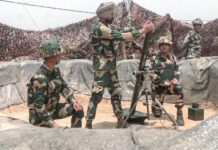Dehradun, Nov 17
Efforts to rescue 40 workers trapped in an under-construction tunnel in Uttarkashi appeared to get back on track on Thursday as a high-capacity machine, flown in from the national capital, started the drilling process. The men have been trapped there since 5.30 am on Sunday.
According to information provided by the Uttarkashi District Emergency Operation Center, the operation began around 10.30 am on Thursday, and by 4.30 pm, it had drilled through 9 metres and was still going on.
Though the workers are safe – they are being provided oxygen, food and water through a pipe – the rescue operation has not been without hiccups.
In the first two days, attempts to clear the rubble using large digging equipment failed since every time debris was removed, more would fall and take its place.
On Tuesday, rescuers abandoned the traditional method, and adopted a “trenchless” technique of digging, using an auger machine to create a stable passage using 900 mm mild steel pipes for the men to crawl through. The first machine brought in for the job, however, was not strong enough.
On Wednesday, a bigger, American-made ‘horizontal dry drilling equipment with auger’ was requisitioned from Delhi. The plan remained the same – of using the trenchless technique to create a small but stable passage for the workers.
Officials overseeing the rescue operation told The Indian Express there is a high chance that the current rescue plan will work, but in case it does not, they have backup plans ready.
“There is a high chance that plan B will be successful. It is just a matter of a few hours. In the first half an hour, the machine has penetrated around 3 metres, which is good. But we are going at it cautiously so that we do not damage the equipment.
There could be some impediments inside. There are bent metal lattice girders and ribs in the rubble. However, chances of boulders (being inside the debris) is less,” Patil told The Indian Express.
He added that the machine is capable of smashing through these impediments, but it is better to avoid them altogether. The machine, said Patil, is seldom used in these kinds of operations. He said that giving an exact timeline of the rescue operation would not be possible as the speed of drilling could increase or decrease. He said they do not have a machine to look inside the debris and determine what is in it.
On Wednesday, speaking to The Indian Express, Bhupendra Singh, DGM, Rail Vikas Nigam Limited (RVNL), said that if the current plan does not work, the final option will be using conventional drilling using the pipe roof umbrella method. Under that, the rescuers will build an entire tunnel and it will take five to six days to reach the men. “However, we are sure it will not come to that and the second plan will work,” Singh said.
Meanwhile, talking about the tunnel and if the incident could have been avoided, he said that in the last four and a half years since the tunnel has been under construction, there was no indication of any complications.
“We had been continuously doing 3D monitoring and data monitoring, and we did not find anything that could suggest this was a crash zone or that it could collapse.
We started the reprofiling with a lot of caution and thought process. We completed the 2.3 km (of the tunnel, from the Silkyara side) with great speed,” he said.
Patil informed that the 4.5 km long Silkyara-Barkot tunnel used the New Austrian Tunnelling Method (NATM), which is basically a combination of drill and blast.
“The primary thought process behind this method is to continuously monitor the deformations as you go in. More deformations, more caution, more rock bolts, and more primary support are required,” said Patil.


























